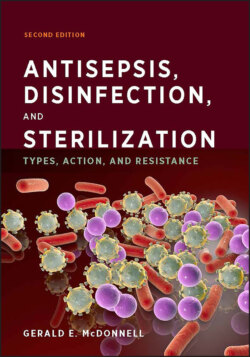Читать книгу Antisepsis, Disinfection, and Sterilization - Gerald E. McDonnell - Страница 14
1
INTRODUCTION 1.1 GENERAL INTRODUCTION
ОглавлениеMicrobiology is the study of microscopic organisms (microorganisms). Microorganisms play important roles in our lives, for our benefit as well as to our detriment. Of primary interest are those microorganisms that cause diseases under a variety of circumstances. Other issues include the economic aspects associated with microbial contamination, such as food spoilage, plant infections, and surface damage. The control of microorganisms is therefore an important concern in preventing contamination, as well as removing or reducing it when it occurs. A variety of physical and chemical methods are used for these purposes in antisepsis, disinfection, and sterilization applications. Disinfection and sterilization are used for the control of microorganisms on surfaces, in liquids, or in areas, while antisepsis is particularly associated with microbial reduction on the skin or mucous membranes. These biocidal applications are varied and include skin washing, wound treatment, product preservation, food and water disinfection, surgical-device decontamination, and product sterilization. Many of these processes have been used historically and are described in many ancient texts and writings. Despite this, it is only in the last 150 years, as our knowledge and understanding of microbiology has expanded, that the impact of antiseptics, disinfectants, and sterilants has been truly appreciated. Their utilization has played and continues to play an important role in significantly reducing the incidence of infectious diseases, such as gastroenteritis and pneumonia. Today, microorganisms are still a significant cause of morbidity, mortality, and economic loss, and we continue to be challenged with the identification of “newer” microorganisms, like Legionella, antibiotic-resistant bacteria, human immunodeficiency virus (HIV), Ebola virus, viroids, and prions.
Biocidal processes include many physical and chemical methods. Physical processes include heat (e.g., steam) and radiation (e.g., UV radiation). A wide range of chemicals, such as aldehydes, halogens, and phenolics, are also used due to their antimicrobial activities. The choice and use of a biocide will depend on the required application. For example, many aggressive chemicals or high-temperature processes can be used on various hard surfaces, like medical devices, but would not be acceptable for use as antiseptics on the skin. Therefore, there are three primary considerations in the choice of a biocide: antimicrobial efficacy, safety, and compatibility. There is no perfect biocide for any application, but the desired attributes include the following:
Activity against a wide range of (if not all) microorganisms
Rapid activity
Efficacy in the presence of contaminating organic and inorganic materials, which can inhibit the activity of the biocide
Low or no toxicity, irritancy, mutagenicity (causing genetic mutations), or carcinogenicity (causing cancer)
Safe use
Lack of damage to surfaces or areas (compatibility)
Lack of unwanted or toxic residues
Stability, yet ability to be readily broken down in the environment
Environmental friendliness
It is clear that the advantages and disadvantages of each biocide should be considered in deciding its suitability in a given application.
This book describes the major antiseptic, disinfectant, and sterilization practices that are used. For the purpose of introduction, this chapter gives a brief description of the various types of target microorganisms, as well as a discussion of some key considerations for biocidal applications, including the evaluation of efficacy, formulation effects, and the importance of cleaning. Chapters 2 and 3 describe the various types of physical and chemical biocides and biocidal processes, including filtration, which is not a true biocidal process but is widely used in the disinfection and sterilization of liquids and gases. For each biocide group, the various types, applications, spectra of antimicrobial activities, advantages, and disadvantages and a brief discussion of the mode of action are given. Chapter 4 addresses the use of biocides as antiseptics and antiseptic applications. Chapters 5 and 6 discuss various types of physical and chemical sterilization methods, which are considered distinct from disinfection applications. Chapter 7 addresses the current understanding of the mechanisms of biocidal action on microorganisms. In most cases, the modes of action of biocides are quite distinct from the more specific anti-infective agents, like antibiotics. Biocide mechanisms are considered in four general groups with similar mechanisms of action, including oxidizing agents, cross-linking agents, action by transfer of energy, and other structure-disrupting agents. Finally, chapter 8 introduces the growing concern about microbial resistance to biocides. This topic has been particularly well studied in bacteria, and a discussion of the various intrinsic and acquired mechanisms of resistance is provided. Further, descriptions of specific mechanisms of resistance in viruses, prions, and fungi and other eukaryotes are also given.
